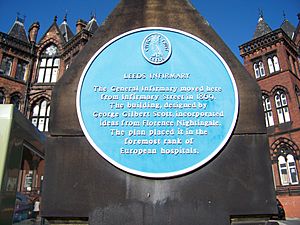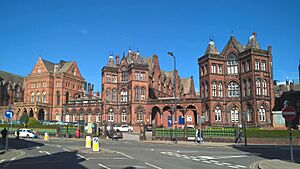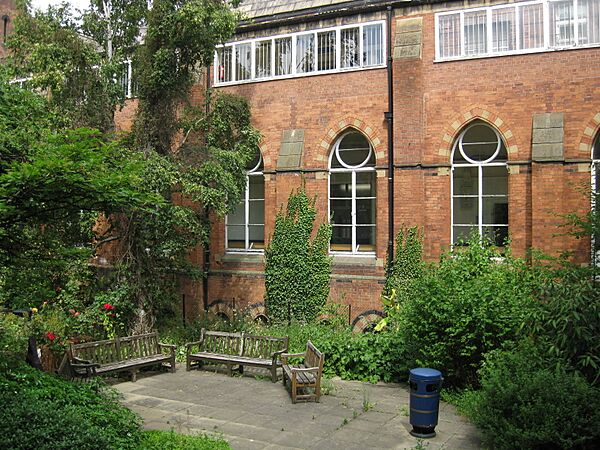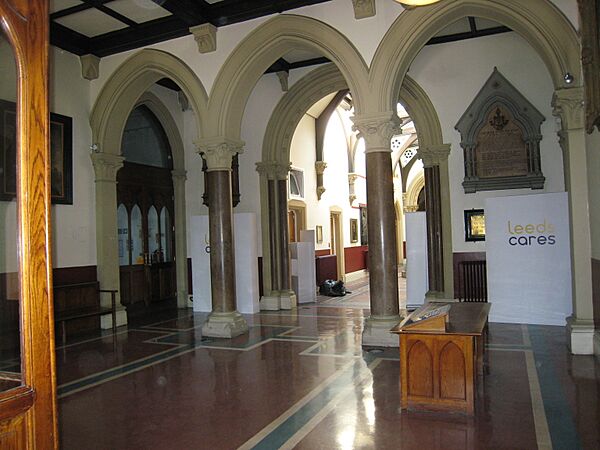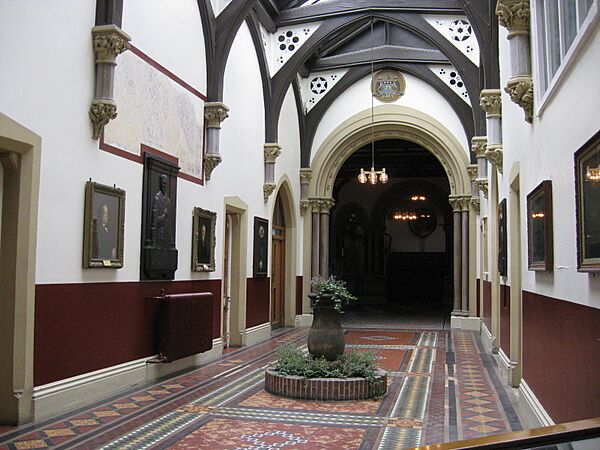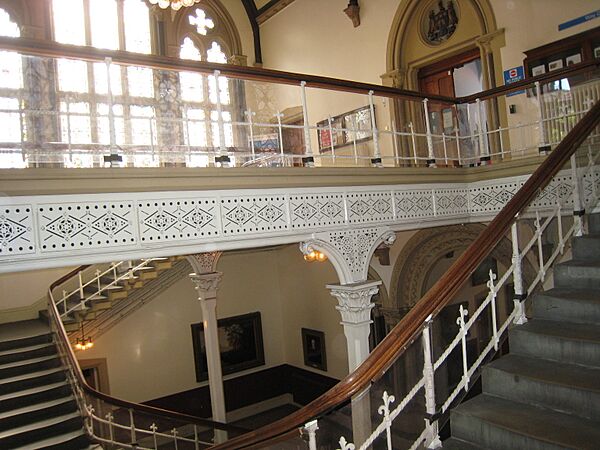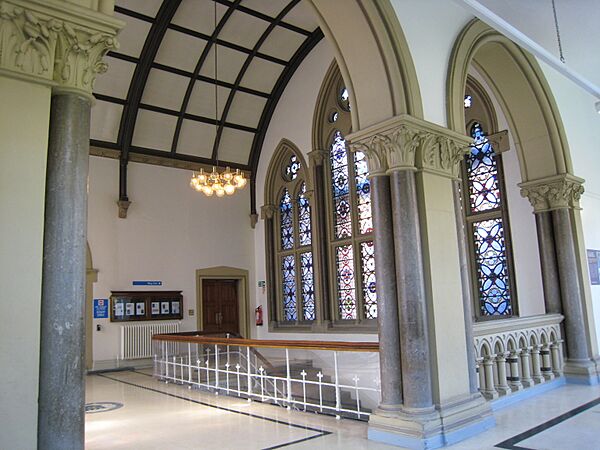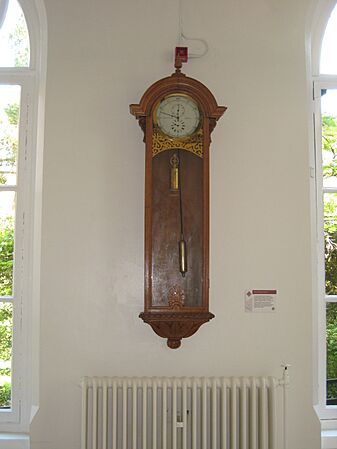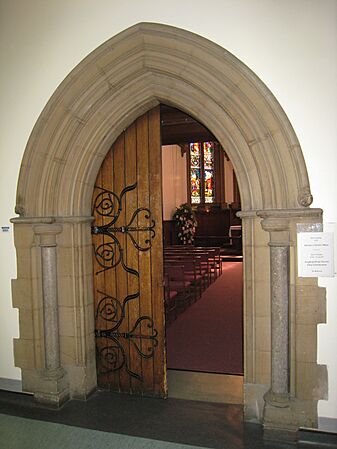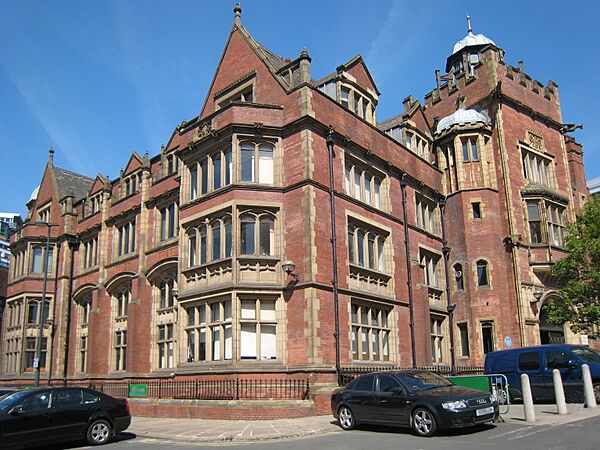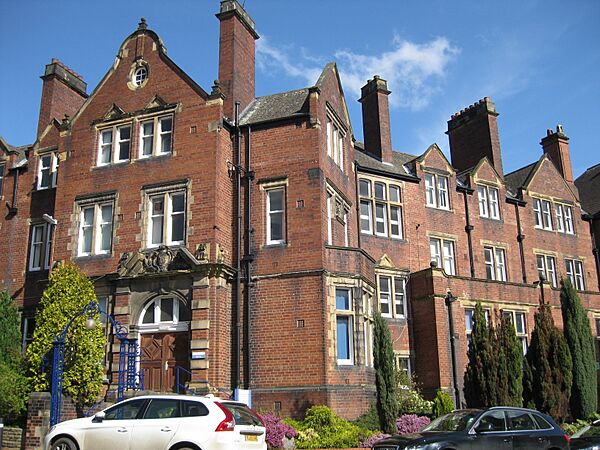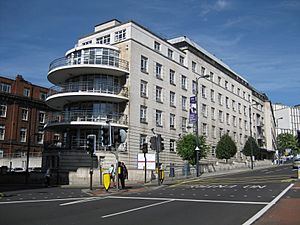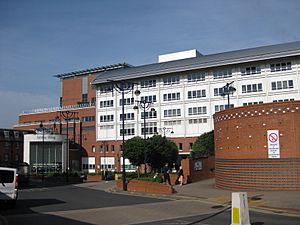Leeds General Infirmary facts for kids
Quick facts for kids Leeds General Infirmary |
|
|---|---|
| Leeds Teaching Hospitals NHS Trust | |
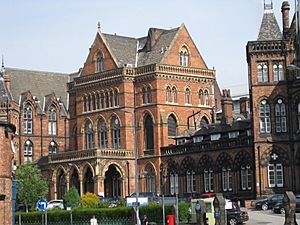
Old George Street Entrance
|
|
| Lua error in Module:Location_map at line 420: attempt to index field 'wikibase' (a nil value). | |
| Geography | |
| Location | Leeds, West Yorkshire, England |
| Organisation | |
| Care system | NHS |
| Hospital type | Teaching |
| Affiliated university | Leeds School of Medicine |
| Services | |
| Emergency department | Major Trauma Centre – (Adult and Children) |
| Beds | 1103 |
| History | |
| Founded | 1771 (current site opened 1869) |
The Leeds General Infirmary, often called the LGI, is a very large hospital in the middle of Leeds, West Yorkshire, England. It's a big part of the Leeds Teaching Hospitals NHS Trust, which runs several hospitals. Sometimes, people still use its older name, The General Infirmary at Leeds.
The LGI is special because it's a main centre for certain medical services. For example, it's a Major Trauma Centre for the region, meaning it treats people with very serious injuries. It also performs amazing hand transplants. Besides these special services, it offers many general hospital services like the A&E (Accident and Emergency) department, intensive care, and maternity care. There's even a helipad on the roof of one of its buildings, so the Yorkshire Air Ambulance can land directly at the hospital.
Two new hospitals are planned to be built on the site. One of these will be a maternity unit, designed to help deliver up to 10,500 babies each year. These new buildings are expected to be finished between 2026 and 2028. This will make it easier for expectant mothers, as they won't need to be moved between different hospitals.
Hospital History
Early Beginnings
The very first hospital in Leeds, called Leeds Infirmary, opened its doors in 1771. It was located on a street now known as Infirmary Street, near City Square. The first five doctors who helped start the infirmary all studied medicine at the University of Edinburgh Medical School.
Building the Current Hospital
Work on the current hospital building, located on Great George Street, began in 1863. The famous architect Sir George Gilbert Scott designed it, and a company from Bradford, J and W Beanland, built it.
Before designing the hospital, Gilbert Scott and the hospital's chief doctor, Dr. Charles Chadwick, visited many large hospitals across Europe. They were very impressed by hospitals that followed the "pavilion plan," which was suggested by Florence Nightingale. This plan was used for the new LGI. It included new ideas like plenty of baths and toilets, and special lifts to help nurses and attendants. However, the very high ceilings that Nightingale suggested made it hard to keep the building warm. Also, the bathroom doors were too narrow for wheelchairs.
Grand Opening
Even though the building was finished in 1868, it didn't have any patients for the first year. Instead, it hosted a large art exhibition to try and earn back some of the £100,000 it cost to build. Sadly, after half a million visitors, the exhibition only made £5 profit. The hospital was officially opened on May 19, 1869, by Prince Albert, who was the Prince of Wales at the time and later became King Edward VII.
Hospital Expansions
Over the years, the hospital has grown a lot.
- Between 1891 and 1892, the building was made bigger by architect George Corson.
- The Brotherton Wing, which now faces Millennium Square, opened in 1940.
- The Martin and Wellcome Wings opened in the 1960s.
- The Worsley Building, home to the Leeds Dental Institute and the Leeds School of Medicine, opened in 1979.
- The Clarendon Wing opened in 1984. This wing replaced the old Leeds Women's and Children's Hospital and now houses the Leeds Children's Hospital.
- The Jubilee Wing opened in 1998. It was named to celebrate the 50th anniversary of the National Health Service (NHS). This wing has new Emergency Department services and special facilities for heart surgery (cardiothoracic) and brain surgery (neurosurgery). It's also the main entrance to the hospital and connects to all the other parts.
Hospital Buildings
Victorian Architecture
The main entrance to the old hospital was on Thoresby Place, but the side facing Great George Street was designed to be the most beautiful. Gilbert Scott's design uses a style called Gothic Revival, with red bricks, stone decorations, red granite pillars, and a slate roof with pointed towers.
The original design was similar to the Lariboisière Hospital in France. It had a "pavilion" layout, which allowed for good light and air circulation in the wards. There was also a Winter garden in a central glass-covered courtyard. The garden is still there, but the glass roof was removed in 1911.
There are three wings (sections) on the north and south sides of this courtyard. The central south wing is the Great George Street entrance, which has a covered porch. Inside, there's a reception hall with a large fireplace. This leads to a corridor with a glass roof and columns decorated with carvings of medicinal plants by William Brindley. The floor is made of mosaic tiles. This corridor leads to a staircase with fancy ironwork and stained-glass windows. Because the hospital is on a slope, this staircase leads up to the main floor where patients enter from Thoresby Place. The lower Great George Street level was used for offices and storage, while the top two floors were for patient wards.
Around the garden corridor, you can find a clock made by Potts of Leeds. Just down the corridor is a chapel dedicated to Saint Luke, which opened in 1869.
The three wings on the south side are connected by single-story covered walkways, forming the south front of the building. Another open walkway to the east and another wing were built later by George Corson, matching the original style.
Inside the Old Building
Other Old Buildings
To the west of Thoresby Place is the School of Medicine, built in 1893. It's a historic building designed by William Henry Thorp in a style called Perpendicular Revival. Some parts of its entrance hall are decorated with special tiles called Burmantofts Faience.
The Nurses' Home, built in 1897, is also by Thorp and has a similar style. It's located north of the Brotherton Wing.
Brotherton Wing
The Brotherton Wing, on Calverley Street, is made of Portland Stone, matching the Leeds Civic Hall across the road. It was a gift from Charles Frederick Ratcliffe Brotherton and opened in 1940. It was planned in 1926 with a modern design, including semi-circular balconies at the south end where patients were meant to get fresh air. However, this didn't work out well due to car traffic and pollution.
Clarendon Wing
This building, opened in 1984, is home to the Leeds Children's Hospital. When it first opened, it replaced an older women's hospital. It was designed to be quite independent from the main hospital, with its own kitchens, labs, operating rooms, and loading area. It's a separate building made of dark brick and grey slate, with four floors built around a central courtyard. The Leeds Inner Ring Road runs in a tunnel underneath it.
Jubilee Wing
The Jubilee Wing opened in 1998 and cost £92 million. It's a major expansion that connects the different hospital buildings and provides a new main entrance off Clarendon Way. It has an L-shape, with seven floors made of red brick and white metal, and curved roofs. There's a large, curved glass entrance. Outside, Jubilee Square helps manage vehicle and pedestrian traffic. It's decorated with special brickwork by Tess Jaray, flower beds, and sculptures by Tom Lomax. This wing also has the helicopter landing pad for the Yorkshire Air Ambulance Service.
People Connected to the Hospital
Many important people have been associated with the LGI:
- Lucy Gwendoline Duff Grant (1894–1984) was a principal tutor for the nursing school and later an assistant matron. She became president of the Royal College of Nursing and the National Council of Nurses of the United Kingdom.
- John Goligher was a world-famous surgeon who specialized in bowel surgery and was a professor of surgery from 1955 to 1978.
- Richard Hammond, a presenter from the TV show Top Gear, was treated at the hospital in 2006 after a serious car crash.
- Berkeley Moynihan, 1st Baron Moynihan was a pioneer in abdominal surgery.
- Nancy Roper, who created a widely used nursing model called the Roper-Logan-Tierney model, became a registered nurse at the hospital in 1943.
- Sydney Clayton Fryers was the House Governor and Secretary. He received an award for his work at the hospital in 1948.
Hospital Services
Trauma Care
The LGI is the main major trauma centre for both adults and children in West Yorkshire. It's one of the busiest in the UK and is ranked among the top three hospitals for providing excellent care to patients with serious, life-threatening injuries.
Heart Services
Heart services are also located in the Jubilee Wing. They include some of the largest services in the country for a procedure called Transcatheter Aortic Valve Implantation (TAVI), which helps people with heart valve problems.
Emergency Department
The LGI has a large and busy Emergency Department for adults. Right next to it, there's a separate, special facility just for children up to 16 years old, which is part of the Leeds Children's Hospital. The adult department was even featured in the first-ever live TV broadcast from an A&E department. This was part of an ITV documentary called "A&E Live," hosted by Davina McCall, which was broadcast live for three nights to celebrate the NHS's 70th birthday. The shows gave people a unique look into how the hospital and its partner services in Leeds work.
Brain and Spine Care
The LGI is the regional centre for Neurosciences, which means it provides special services for spinal surgery, brain surgery (neurosurgery), neurology (brain and nerve conditions), neuro-rehabilitation, neurophysiology, and stroke care. The Leeds Teaching Hospitals NHS Trust was the first regional stroke centre in the UK to use a special imaging system called RapidAI across its stroke network.
Hand Transplants
Professor Simon Kay and his team at Leeds General Infirmary were the first in the country to perform double hand transplants. This amazing work was possible thanks to the expert care from the hand and plastics units. In 2016, Chris King was the first person in the UK to receive a double hand transplant. In 2018, Tania Jackson became the first woman in the UK to have a double hand transplant.
Pathology Labs
The pathology labs, located in the Old Medical School at LGI, process thousands of medical samples every day. The Prime Minister, Boris Johnson, visited these services to learn about future plans after the Department of Health announced £12 million in extra funding. This money is for developing a single Laboratory Information Management System (LIMS) across West Yorkshire and Harrogate.
See also
- List of hospitals in England
- Grade I listed buildings in West Yorkshire
- Listed buildings in Leeds (City and Hunslet Ward - northern area)


